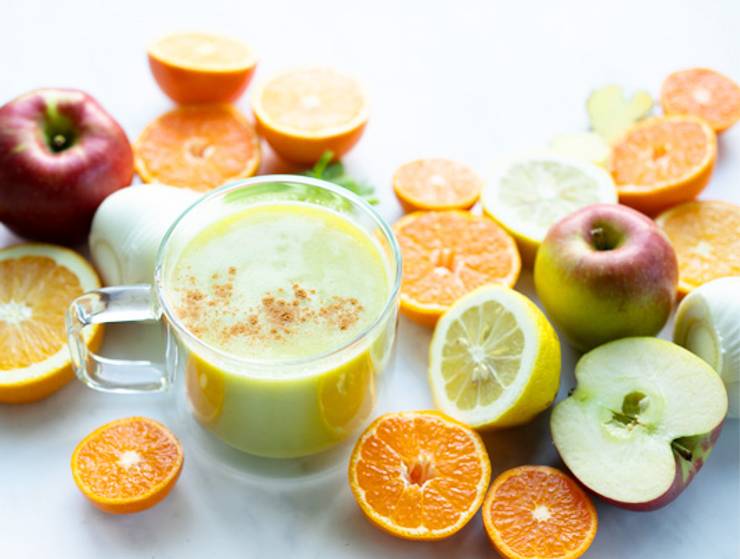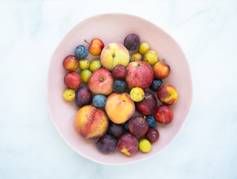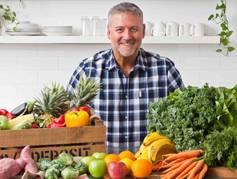Articles
A Guide to Warming Up Winter With Juice
The leaves on the trees have retreated and much of nature has begun to hibernate now that December is here. It’s typically a season where we spend more time indoors due to colder weather and less sunlight because of the shorter days.
But what if we looked at winter through a different lens? Maybe we don’t need to hibernate, but we can rejuvenate.
John Douillard, an expert in natural health and Ayurveda, calls winter a season for rejuvenation and “a kind of pulling back of the bow in preparation for an active spring and summer.”1
He recommends striving to get extra rest during winter months, which can help the body boost its own immune reserves.
This advice may seem counterintuitive to your December plans so remember to find the balance that works best for your mind and body. While some people are energized by keeping their schedules full with parties and events, others prefer more downtime and a slower pace this month.

“Growing up in Michigan, the winter season brings a time to appreciate the magic of snow and the sense of quiet and calm that it creates,” says Carrie Schabel, a holistic health and wellness coach based in Detroit, Michigan. “Wintertime creates slower-moving energy, which we can embrace in different ways. Giving yourself space to reflect on the past year, as well as creating goals while welcoming the new year, is a great place to start.”
What Is the Winter Solstice?
The winter solstice (in the Northern hemisphere) arrives on December 21. Also known as the hibernal solstice, it marks the longest night of the year, and the shortest day. Observing the winter solstice dates back to the Neolithic period with monuments, such as Newgrange in Ireland and Maeshowe in Scotland, aligned with sunrise on the winter solstice, according to history.com.2
Yule is a winter celebration that the ancient Norsemen of Scandinavia celebrated, believed to take place around the winter solstice as well. In Norse poetry, the term “yule” referred to a feast. Fathers and sons would bring home large logs to celebrate the return of the sun, which became known as yule logs. It’s said that they would feast until the log burned out, which could take more than a week.
With many holidays in December, it can often be a time of overconsumption with food, gifts and more. You can reimagine this season of giving not just to others but to yourself, as well. Remember to nurture and nourish your body with seasonal produce in the form of juice or however you wish to enjoy more fruits and vegetables.
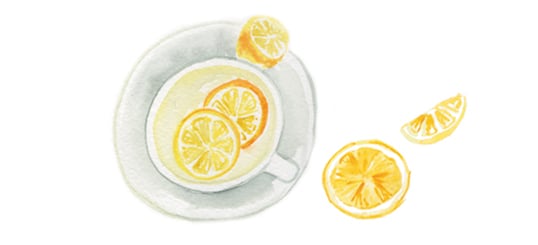
Winter Rituals
One of the ways Coach Carrie welcomes the season is to warm up her lemon water as her first drink of the morning to help hydrate the body.
“During the wintertime, I warm my lemon water to better support my body with detoxing, flushing out toxins and hydrating at the same time,” she says. “If you are an early morning coffee or tea drinker, try to add warm lemon water as your first drink of the day, and then enjoy your cup of coffee or tea.”
Even as the season starts to change, she keeps to her daily routine as much as possible.
“As winter approaches, I try to continue my normal routine as much as I can,” she says.
She likes to eat breakfast within the first hour of waking up, have lunch four to five hours later, and dinner by 6:30pm.
“I’m used to eating this way, and if I continue with this consistency, I feel more productive staying on task with work and other things going on in my day,” she shares.
Another favorite ritual she maintains is taking shots, as in, an anti-inflammatory, immune-boosting turmeric shot.
To make the blend, she juices:
- 2 oranges
- 2 lemons
- 2 inches of raw turmeric root
Then, she sprinkles some black pepper on top (the pepper helps with turmeric absorption) and splits the juice into two larger shots.
“I like to add a splash of coconut water for a natural hydrating electrolyte boost,” she says. “You can play around with the ingredients and make the juice blend to your taste preferences.”
She also has a favorite self-care routine she loves to incorporate in the winter months to help her shake that cold winter chill. She spends time relaxing in an infrared sauna.

“This type of sauna is different from the traditional steam saunas that may be more familiar,” she explains. “The lamps in infrared saunas can penetrate warmth directly on the skin, which can create heat-therapy benefits.”
Some of the many health advantages to using this type of sauna include fighting off illness, stress relief, relaxation, pain relief, and detoxing.3
If you want to try an infrared sauna, you can typically find them in health and fitness centers. Some chiropractic and wellness clinics have them available to use as well, and may offer packages with reduced rates. If you find you are using an infrared sauna on a regular basis, there are many models of in-home saunas available as well.
“Yes, the winters can be long and cold,” Carrie shares. “If we can try to shift our mindset and find balance with being active, and also allow ourselves to slow down and give the body a chance to rest and reset, we will find ourselves naturally going with the flow of the season.”
Staying Warm
With the first day of winter approaching, you may be worried about how to stay warm and whether it’s okay to juice during colder months. When it’s cold, snowy and/or dark outside, you may crave foods and activities to keep you warm.
“Winter is a time our bodies naturally crave more warming, comfort foods,” Coach Carrie says. “Maybe you have favorite family recipes you love to make during the winter months. Soups, stews, chilis, warm fresh bread and more sound so good during those colder months.”
She recommends trying to re-make some of your favorite recipes with healthier ingredients, such as using almond flour instead of white flour and adding more vegetables to soups and stews.

Consider letting juices come to room temperature before enjoying them or even warming them up by adding hot water or adding warming spices. The best ingredients to warm up your juice are: ginger, pepper, cinnamon, cardamom or turmeric.
Try this Winter Warmer Juice Recipe to warm up this winter.
Another way to stay warm is to move your body. Carrie recommends reimagining your outdoor activities to stay active even when it’s cold outside.
“Outdoor activities go from swimming, boating, and biking to snow skiing, ice skating and just playing in the snow,” she explains.
In fact, getting outside has many benefits for both your mind and your body, according to Rachel Hopman, Ph.D., a neuroscientist at Northeastern University, who has studied how much time to spend in nature to feel healthier and help reduce stress.
In one of her studies, she found that a 20-minute stroll through a city botanical garden (or any outdoor park) can help boost cognition and memory as well as improve feelings of well-being. The only caveat is that you need to ditch your phone. She found that people who used their cell phones while walking saw none of the benefits.

Coach Carrie admits that finding time for movement can be more challenging in the winter months.
“For those that prefer to get their exercise outdoors (that’s me!), continue to do so as long as you can into the winter season,” she encourages. “Bundle up for those winter walks, but be sure it’s not icy on your walking path. I always recommend doing what you enjoy when it comes to exercise, as long as you continue to do something, and move your body in some way.”
She also says accountability is key in the winter months.
“I try to plan my yoga classes with a friend, so that gives me the extra push I need at times to get out of the house on a cold evening.”
-v1671129703804.jpg)
Staying Veggie-Focused in Winter
Coach Carrie reminds us to search for fresh produce throughout the winter months.
“Living in Michigan, you may think that our farmers’ markets are only open during warmer months, but we actually have some markets that are open year-round,” she says.
One of her favorite places to visit in the winter is the historic Eastern Market in Detroit, where they sell local produce and other local items.
“Some farmers/vendors will continue growing cool weather produce in greenhouses or hoop houses during the winter months,” Carrie says. “Try doing a search for winter markets in your area, and you may be surprised by what they have to offer.”
She’s also trying a new project this winter—growing an indoor hydroponic garden.
“Being able to pick fresh lettuce, and herbs to add to dinner right from your kitchen garden in the middle of winter…I’m in!” she says.
If you want to keep it smaller, you can grow your own warming herbs like thyme and oregano, on your windowsill. If you don’t have enough daily sunlight (4-5 hours), you can substitute by using a grow light.

Our Favorite Produce Available in December
Here’s our guide to some of the best seasonal fruits and vegetables this season. Remember: seasonal foods will vary depending on where you live, soil conditions and weather.
BEST DECEMBER FRUITS
CLEMENTINES
These sweet, seedless, tiny fruits, also known as Halo or Cutie oranges, are easy to peel and packed with vitamin C, making them a great choice for winter citrus.4 Clementine season revs up in November and December, when the trees start producing a bounty of fruit. They can help sweeten the taste of any juice, even more than a regular orange.

• Shopping Tip: Look for citrus that is shiny, bright and blemish-free and dodge any that feel too firm.
• Storage Tip: Clementines don’t belong in the refrigerator. Instead, keep them on the counter out of direct sunlight in a bowl. Avoid the urge to store them in plastic bags, which can make them spoil faster.
PEARS
Ralph Waldo Emerson famously said, “There are only ten minutes in the life of a pear when it is perfect to eat.” But in all seriousness, pears are a subtle and sweet-tasting fruit that contain many essential nutrients including fiber, potassium and vitamin C.5 Most pears found in North America are grown in Oregon and Washington, and their growing season lasts from late summer into February. Asian pears are great for juicing as they have a more crisp, apple-like texture than other varieties.

• Shopping Tip: Some people like their pears very firm, while others prefer to eat them when they are softer and riper. A good rule of thumb is to go for firm pears (that can soften at home) and never buy them when they are mushy or have dark spots.
• Varieties: It’s worth exploring many different kinds of pears including red and green Bartletts, red and green Anjous, Bosc, Asian and Seckel.
• Storage Tip: Pears are another fruit that are great to store in a bowl on the counter out of direct sunlight. If you want them to soften faster, you can put them in a paper bag.
POMEGRANATES
The name pomegranate comes from the Middle French term “pomme garnete,” which translates to “seeded apple.”6 These round, red fruits are filled with vibrant seeds that can be intimidating to remove. We’ll give you some tips in a moment. Whatever labor it takes to remove them is worth it, as pomegranate seeds contain a healthy dose of magnesium, potassium, folate and vitamin C.7 Research also show that pomegranate extract may help reduce the formation of kidney stones.8 The two countries that lead the world in pomegranate growing are India and Iran, and in the U.S. California, Arizona and Texas also grow these delicious fruits.

• Shopping Tip: Look for ones that are plump and round, feel heavy and are free of any bruises.
• Seed Removal Tip: Start by cutting off the top of the pomegranate so you can see the seeds. Next, use a sharp knife to make lengthwise slits into the white sections of the fruit. Then, pull it apart into sections. Gently pop the seeds out of each section. It may be easier (and less messy) to do this in a bowl of water. Check out this video demo for more tips.
• Juicing Tip: Don’t feed the whole pomegranate into the juicer, as you’ll end up with a bitter drink. Instead, use the method above to remove the seeds and then add them to your juicer. Try them in this Phyto-Red juice recipe.
BEST DECEMBER VEGETABLES
BROCCOLI
Gardeners know that broccoli is great to plant in fall gardens because this hearty green can last through frost and into wintertime. Broccoli has been grown in Europe for centuries, but has only been grown in the United States since 1925, according to the Agricultural Marketing Resource Center. It’s now grown in nearly every state. The stalks can be quite fibrous and tough, which makes them great for juicing, as it helps reduce the fiber content while maintaining the vegetable’s nutritional value.
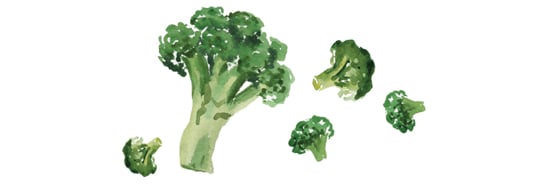
• Shopping Tip: Look for tight, bright floret clusters and don’t bring home broccoli heads with any hints of yellow, as the flavor will be more bitter.
• Storage Tip: This green goes in the fridge and should last up to a week.
WINTER SQUASH
An interesting fact about winter squash is that they are typically harvested in late summer, but they get their name because they keep well into the winter months. Not all of these squashes are ideal for juicing but here are a few that work well: delicata, butternut, sugar pumpkins and carnival. Generally, these squash are known to deliver a healthy dose of vitamins A and C, antioxidants, fiber and potassium.9

• Shopping Tip: Unlike other fruits that get mushier as they ripen, winter squash become more firm as they mature. Choose a squash that feels firm without soft spots or cracks.
• Storage Tip: Keep winter squash in a cool dark spot in your kitchen and do not refrigerate them. While they can last several months, for the best flavor try to use them within a month or so.
COMMUNITY MEMBER SPOTLIGHT

Juicing Tips
from Victoria Watanak
1. What are your favorite warming winter juicing tips?
For warming winter juices, I like to incorporate ingredients that add heat. I'll add red bell pepper, ginger or turmeric to my juices to give me that warming feeling and they have amazing nutritional benefits too!
2. How do you spice up your juice for the holidays?
Spices such as cinnamon and nutmeg pair well with some of my favorite juices, especially the creamy ones. Cinnamon and nutmeg are both rich with antioxidants, have anti-inflammatory properties and are just delicious! I'll add these with fruits and veggies in season such as apples, cranberries, and even pumpkin for a spiced juice for the holidays.
Inspiring Nonprofits to Know About
This month, we celebrate a few nonprofits that make fruits and vegetables more accessible to everyone. If you’re in the mood to give, consider supporting some of these organizations that are doing wonderful things for their communities.
KISS THE GROUND
Kiss the Ground is a California-based nonprofit working to regenerate land and reverse climate change through rebuilding healthy soil. They create educational curriculum, campaigns, and media to raise awareness and empower individuals to purchase food that supports healthy soils and a balanced climate. The org also works with farmers, educators, NGOs, scientists, students, and policymakers to advocate for regenerative agriculture, and help drive brands and businesses to develop more sustainable supply chains worldwide. Locally, they operate a community garden in Venice, California, demonstrating urban permaculture to volunteers and homeless youth.
RODALE INSTITUTE
Growing the organic movement through research, farmer training, and consumer education, the Rodale Institute is known for pioneering and continually advocating for the use of regenerative agricultural practices. Founded in 1947 in Kutztown, Pennsylvania, by J.I. Rodale, the Institute has transformed 333 acres of formerly degraded farmland into highly fertile and productive land growing a variety of organic crops. The farm forms the basis for Rodale’s research, education, and outreach, and it is home to the longest-running comparative study of organic and chemical agriculture, started in 1981.
WHOLESOME WAVE
Wholesome Wave is a national nonprofit based in Bridgeport, Connecticut, fighting nutrition insecurity across the U.S. by developing and deploying programs, platforms, and seed funding to help a network of community-based organizations address the lack of affordability and access to healthy food. When poverty and hunger strike, it’s not just about getting more food, it’s about getting the right food. Addressing food insecurity overshadows the real problem: nutrition insecurity. Through programs like SNAP Double and Produce Prescriptions, Wholesome Wave empowers underserved consumers to make better food choices by making healthier produce more affordable.
sources:
- https://lifespa.com/ayurvedic-lifestyle/seasonal-living/fall-winter-guide/john-douillard-fall-winter-ayurveda-routine
- https://www.history.com/topics/natural-disasters-and-environment/winter-solstice
- https://health.clevelandclinic.org/infrared-sauna-benefits
- https://fdc.nal.usda.gov/fdc-app.html#/food-details/168195/nutrients
- https://fdc.nal.usda.gov/fdc-app.html#/food-details/746773/nutrients
- https://pomegranates.org/faq
- https://fdc.nal.usda.gov/fdc-app.html#/food-details/169134/nutrients
- https://pubmed.ncbi.nlm.nih.gov/25085198
- https://www.hsph.harvard.edu/nutritionsource/food-features/winter-squash
- Choosing a selection results in a full page refresh.
- Press the space key then arrow keys to make a selection.
